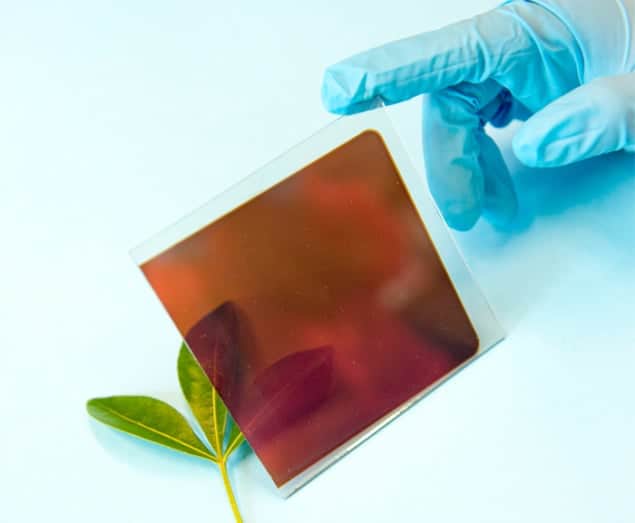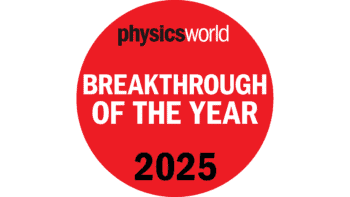
Researchers at the University of Oxford in the UK have made a thin-film solar cell with better than 15% light-conversion efficiency from an emergent class of semiconductors known as perovskites. The devices have a simple architecture and could easily be produced in large quantities because the vapour-deposition process used to make them is compatible with conventional processing methods for fabricating such solar cells.
Organometal trihalide perovskite semiconductors, which have the formula (CH3NH3)PbX3 with X being iodine, bromine or chlorine, were first employed as the light-absorbing component in dye-sensitized solar cells in 2009. In these devices, the perovskites were coated onto the surface of a film made of titanium-dioxide (TiO2) nanoparticles.
When the perovskite layer absorbs light, electrons and holes are generated. These charge carriers are subsequently transferred to different transport materials – TiO2 for the electrons and to another material for the holes. The transport materials then carry the charges to separate electrodes and a voltage is produced. These solar cells have light-converting efficiencies of about 12–15% thanks to the large amount of perovskite packed into the TiO2 film.
Simple structure
Now, two teams at Oxford led by Henry Snaith and Michael Johnston have joined forces to show that perovskites not only strongly absorb light, but also transport both electrons and holes. This new discovery means that the nanostructured architecture previously used in the dye-sensitized solar cells is no longer necessary, which simplifies the device structure greatly. Indeed, in the new device, the light-absorbing perovskites are simply sandwiched between electron- and hole-selective electrodes – a set-up that is, in fact, the same as that used in conventional planar solar cells.
“Our devices have a high solar-to-electric power efficiency of 15.4% and a large ‘open circuit’ voltage of 1.07 V – all in a solar cell in which the absorbing perovskite layer is only 330 nm thick,” explains Johnston. “This means that we only need a tiny amount of perovskite material to make a solar cell with good properties.” In contrast, conventional crystalline silicon cells are much thicker (0.15 mm wafers are typically used) and the voltage produced by these cells is only about 0.7 V under open-circuit conditions.
Photophysics still a mystery
“Little is known about the photophysics of these materials, which I think is quite exciting – this is a rapidly evolving field,” Johnston says. “The fact that we can make such good solar cells using a conventional planar p–i–n architecture indicates that the charge-carrier diffusion lengths (the distances electrons and holes travel before recombining) are long, and that these carriers survive a long time in perovskite. That we can fabricate an efficient device without complex mesostructuring – as was previously the case with solar cells made from this material – also shows that perovskite is very good at both absorbing light and transporting photogenerated charge.”
According to the researchers, these perovskite-based devices should be cheap to make using processes that are compatible with existing solar-cell manufacturing infrastructures. And since they absorb light in a different part of the electromagnetic spectrum to silicon, the two materials might be used together in so-called tandem cells in which a silicon device would be placed underneath a perovskite one. “Here, the perovskite top cell would absorb higher-energy photons and the lower-band-gap silicon the lower-energy ones,” explains Johnston. Such a cell could be more efficient that one made from either silicon or perovskite alone.
Richard Friend of the University of Cambridge, who was not involved in this work, says that this research began out of the Oxford team’s initial interest in dye-sensitized solar cells. These devices are considered to be “excitonic” photovoltaics that require a large surface area for charge separation between electron-accepting TiO2 and the adsorbed dye layer. He says that the team’s new discovery is “remarkable” because it proves that these perovskites work as bulk semiconductors.
It is unprecedented to see such rapid progress in performance
Richard Friend, University of Cambridge
“Last year, this group already reported that the lead-iodide perovskite structure described in this work, formed with an organic semiconductor hole transporter, could produce a power-conversion efficiency above 10%. The new paper reports efficiencies of 15% in a straightforward layer-by-layer structure deposited by very simple evaporation and solution processing techniques,” says Friend. “It is unprecedented to see such rapid progress in performance – with less than a year of development, the material is now close to the efficiency of cadmium telluride (that has been studied for several decades).”
Spurred on by their initial results, the Oxford researchers are now busy optimizing film-deposition parameters and device design. “I think we will see the efficiencies of these devices climbing higher in the near future,” says Johnston. “Investigations into the fundamental photophysics of the perovskite layers will be particularly interesting and will also help us accelerate the optimization process.”
The present results are published in Nature.
- This article first appeared on nanotechweb.org



